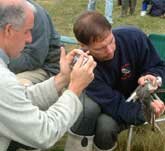
Submit Sighting Tips...
Please download, complete and submit the form to report a sighting of a colour-ringed Greenshank.
What to look for:
The Greenshanks have been fitted with four colour-rings to make it possible to identify them as individuals and build up detailed life histories. Colour-rings can be on the upper leg (tibia) as well as on the lower leg (tarsus). Be careful to check both legs carefully to record all the rings.
The colour-rings used include dark blues and dark greens as well as a pale green (we call lime) and white. These colours can look very similar if not seen well, as can faded yellow or stained white rings! So please take care when recording combinations!
Top tips:
- Draw a simple cross in your note book and fill in the colour-rings using letters for each colour as seen on the birds legs.
- Distinguish between black and dark blue rings by using N for black (or Niger) and B for dark blue - otherwise a B can be either!
- Record the height of rings - they can be either tall or short rings.
- Always record the rings as being on the bird's left or right legs NOT as you may see them e.g. if the bird is standing facing you!
- Note that we also use double colours e.g. two reds one on top of the other which can look like one tall ring.
- Always record left leg first e.g.
- GR WL is green over red on left tibia and white over lime on right tibia.
- W//WR + BTO//W is white on left tibia and white above red on left tarsus opposite BTO metal ring on right tibia and white on right tarsus. The double line represents the "knee" or leg joint.
- Always take time to check and record rings on both legs to make it possible to identify the bird as an individual.
Observations to record:
- Date & time (preferably duration of observation).
- Site name and nearest town.
- Grid reference or latitude/longitude in outside the UK.
- Colour-ring combination.
- Observer name, address, email address & phone number.
Other useful information:
- Flock size.
- Number of birds checked for rings and number ringed.
- Tide state.
- Habitat.
- Notes on behaviour - feeding, roosting etc.
Download information on Greenshank colour-ringing schemes
Top

